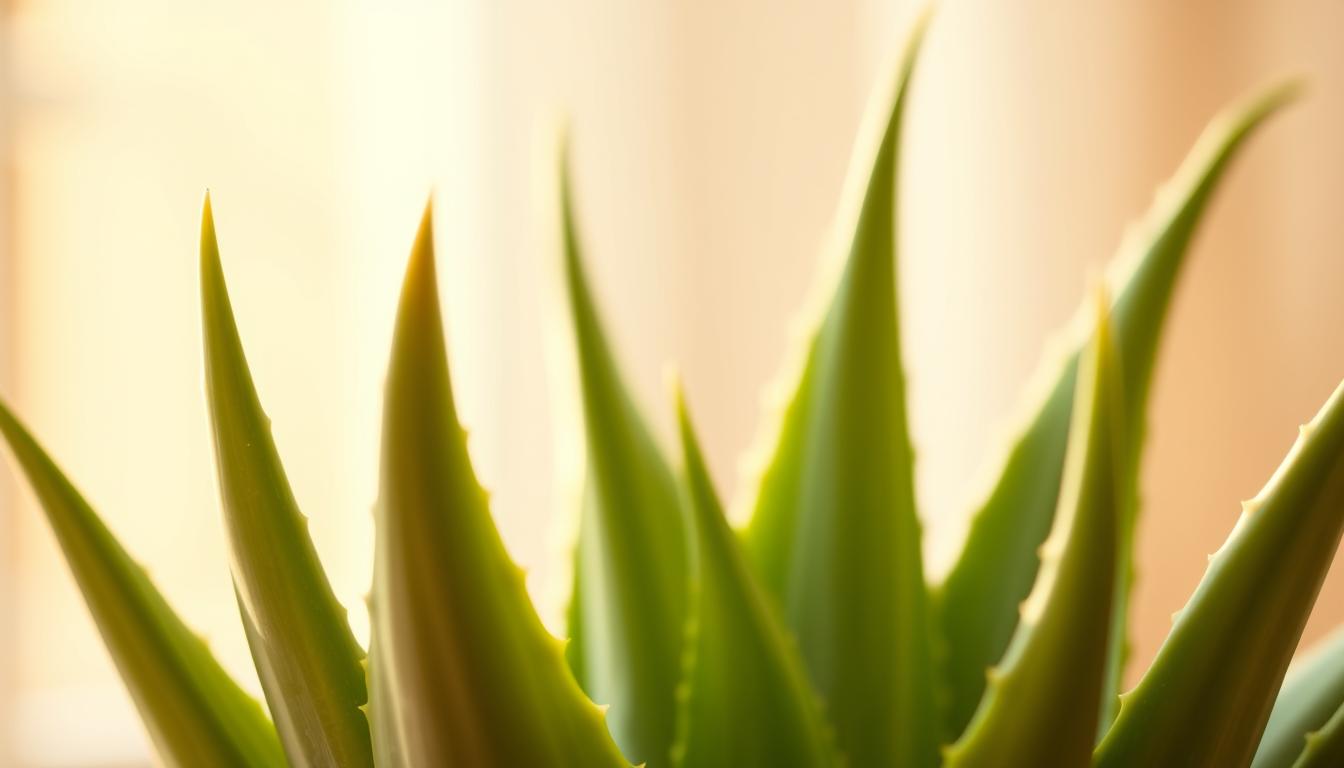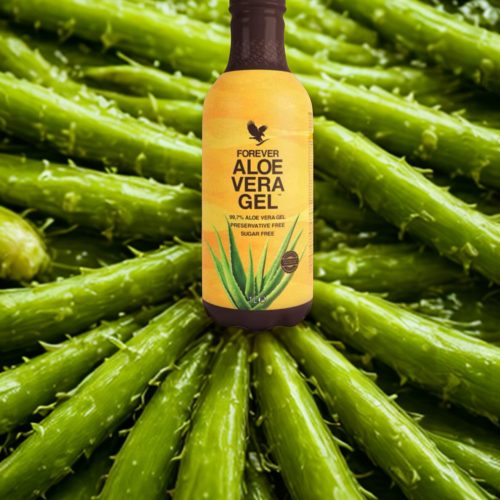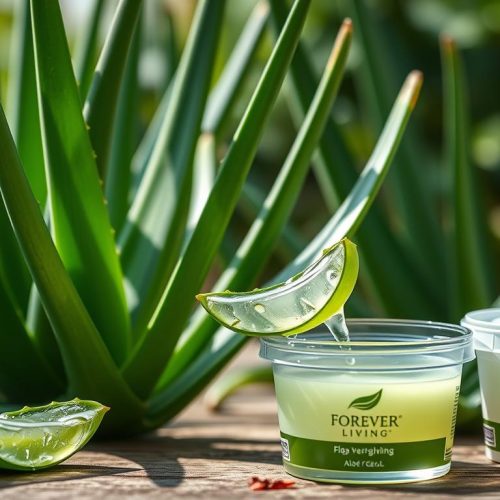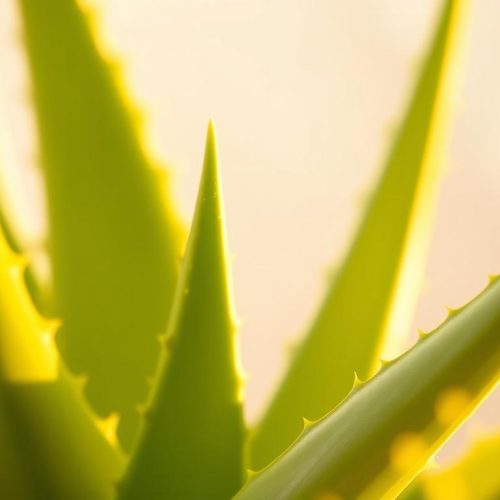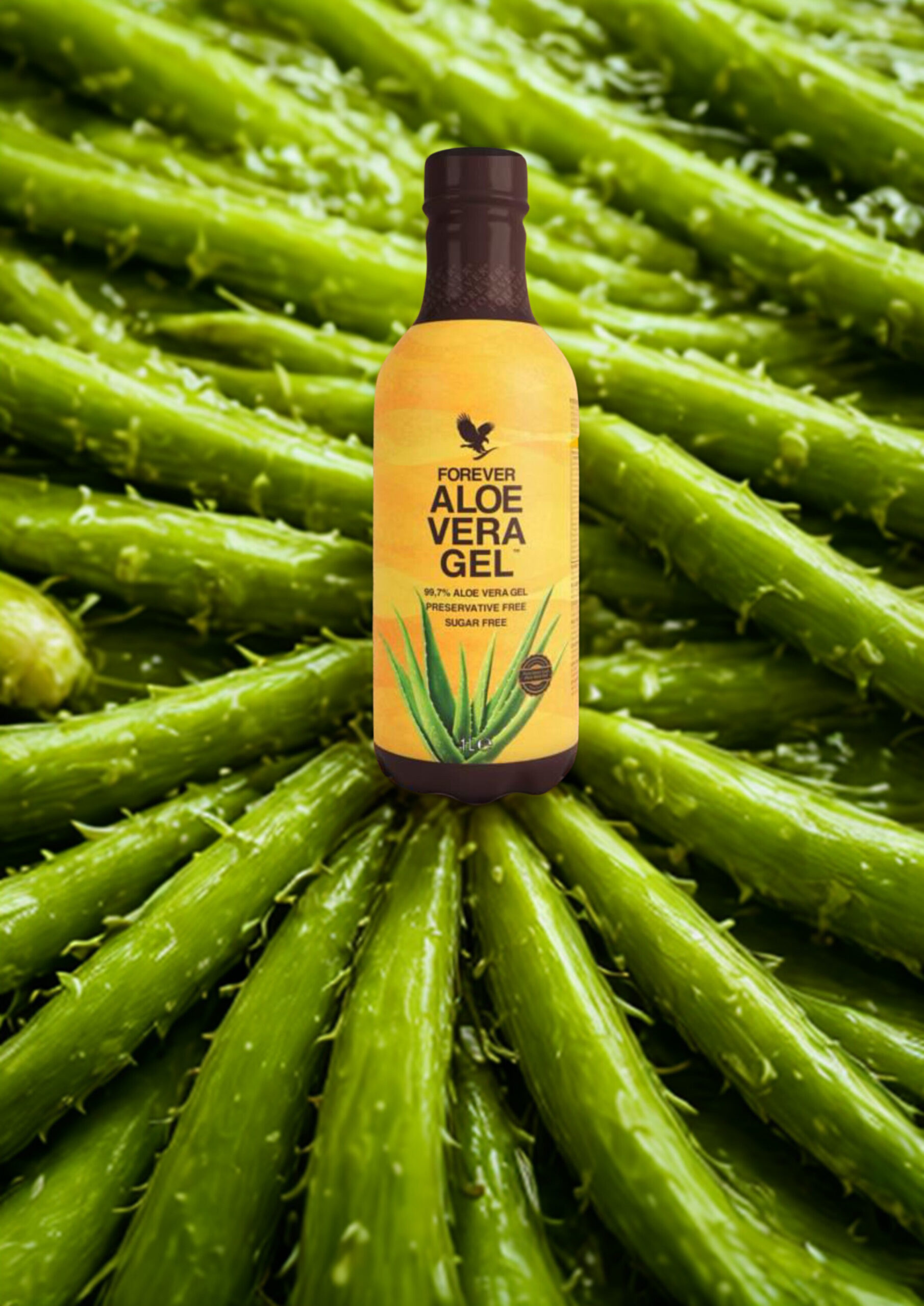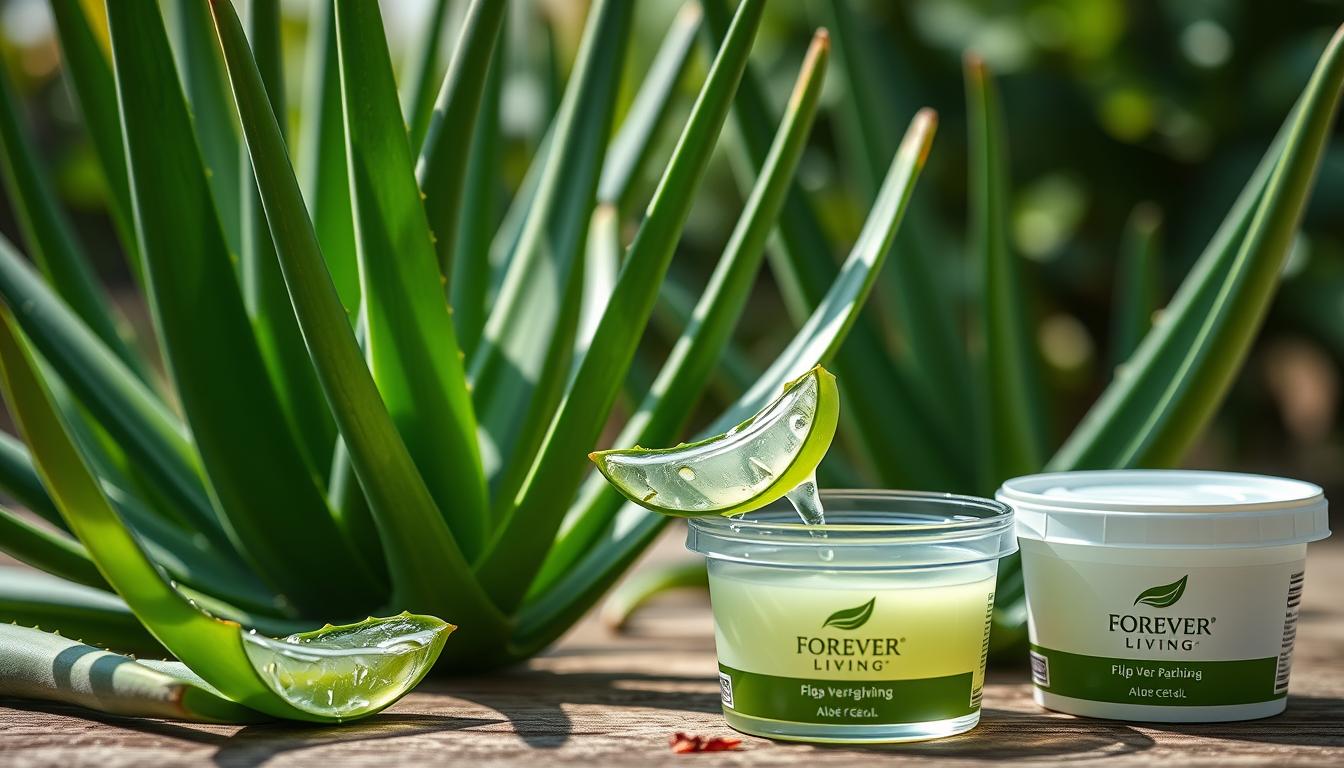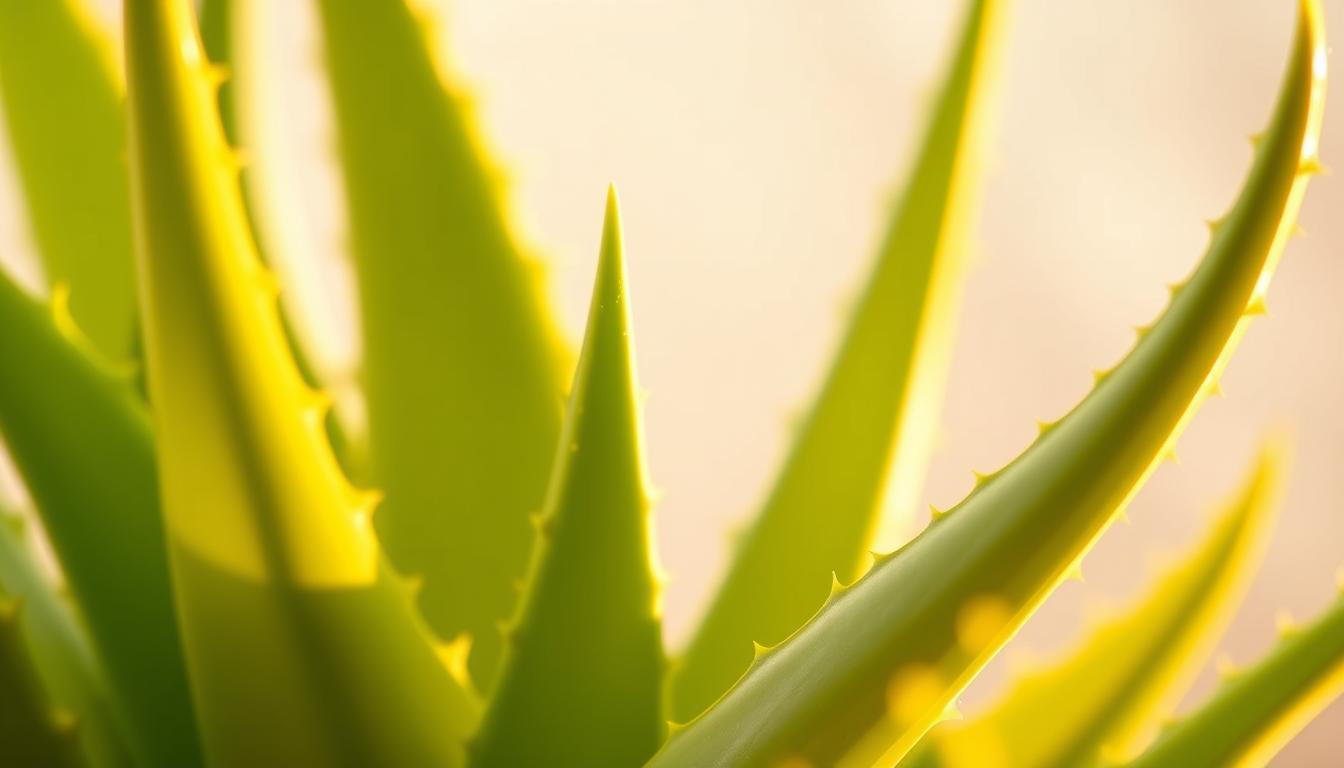Did you know that over 40% of Americans will get sunburned at least once this year? Sunburns not only cause discomfort but can also lead to long-term skin damage. Natural sunburn remedies with aloe vera have been a long-standing solution, praised for their soothing effects.
Aloe vera’s effectiveness in sunburn relief stems from its anti-inflammatory properties and its ability to moisturize the skin. By understanding aloe vera for sunburn relief and how to use it properly, you can maximize its benefits and enjoy healthier, happier skin.
- Understanding Sunburn and Its Effects on Skin
- The Science Behind Aloe Vera for Sunburn Relief
- Healing Compounds in Aloe Vera
- Fresh vs. Store-Bought Aloe Vera: Pros and Cons
- How to Extract and Use Fresh Aloe Vera Gel
- Choosing the Best Aloe Vera Products for Sunburn
- Step-by-Step Guide to Applying Aloe Vera for Sunburn Relief
- DIY Aloe Vera Remedies for Enhanced Sunburn Relief
- When to Seek Medical Help: Beyond Aloe Vera for Sunburn
- Conclusion: Incorporating Aloe Vera into Your Sun Care Routine
- FAQ
- What are the benefits of using aloe vera for sunburn relief?
- How does aloe vera help with sunburn blisters?
- Can I use aloe vera gel directly from the plant for sunburn relief?
- What should I look for when buying aloe vera products for sunburn?
- How often should I apply aloe vera for sunburn relief?
- Can aloe vera be used in combination with other natural ingredients for sunburn relief?
- Is aloe vera effective for all types of sunburn?
- How does aloe vera sunburn spray compare to aloe vera gel?
- Can aloe vera help reduce the redness associated with sunburn?
- Understanding Sunburn and Its Effects on Skin
- The Science Behind Aloe Vera for Sunburn Relief
- Healing Compounds in Aloe Vera
- Fresh vs. Store-Bought Aloe Vera: Pros and Cons
- How to Extract and Use Fresh Aloe Vera Gel
- Choosing the Best Aloe Vera Products for Sunburn
- Step-by-Step Guide to Applying Aloe Vera for Sunburn Relief
- DIY Aloe Vera Remedies for Enhanced Sunburn Relief
- When to Seek Medical Help: Beyond Aloe Vera for Sunburn
- Conclusion: Incorporating Aloe Vera into Your Sun Care Routine
- FAQ
- What are the benefits of using aloe vera for sunburn relief?
- How does aloe vera help with sunburn blisters?
- Can I use aloe vera gel directly from the plant for sunburn relief?
- What should I look for when buying aloe vera products for sunburn?
- How often should I apply aloe vera for sunburn relief?
- Can aloe vera be used in combination with other natural ingredients for sunburn relief?
- Is aloe vera effective for all types of sunburn?
- How does aloe vera sunburn spray compare to aloe vera gel?
- Can aloe vera help reduce the redness associated with sunburn?
Key Takeaways
- Understanding the benefits of aloe vera for sunburn relief
- Learning how to properly use aloe vera for maximum effect
- Discovering the science behind aloe vera’s healing properties
- Exploring natural sunburn remedies that incorporate aloe vera
- Tips for applying aloe vera to achieve the best results
Understanding Sunburn and Its Effects on Skin
Sunburn occurs when the skin is damaged by the sun’s ultraviolet rays, leading to a range of uncomfortable symptoms. This damage triggers a complex biological response in the skin, affecting its structure and function.
What Happens to Your Skin During Sunburn
During sunburn, the skin’s outer layer, the epidermis, is directly affected. UV radiation damages the DNA of skin cells, leading to cell death and triggering an inflammatory response. This results in the characteristic redness, swelling, and pain associated with sunburn. The skin may also become warm to the touch due to increased blood flow to the affected area.
The severity of sunburn can vary from mild to severe. In mild cases, the skin may appear slightly red and feel warm. In more severe cases, blisters may form, and the skin can become severely inflamed, potentially leading to fever and chills.
The Healing Process and Recovery Timeline
The healing process for sunburned skin involves several stages. Initially, the skin’s natural response is to increase blood flow to the damaged area, leading to inflammation. As the body begins to repair the damage, the skin may start to peel, a process that can take several days to a week.
The recovery timeline can vary depending on the severity of the sunburn. Mild sunburn typically heals within a few days, while more severe sunburn can take up to two weeks or more to fully recover. During this time, it’s crucial to keep the skin moisturized and protected from further sun exposure to aid in the healing process and reduce the risk of long-term damage.
Understanding the healing process is essential for appreciating how treatments like aloe vera can help alleviate sunburn symptoms and potentially speed up recovery.
The Science Behind Aloe Vera for Sunburn Relief
For centuries, aloe vera has been utilized to alleviate sunburn, with recent scientific investigations validating its efficacy. The historical use of aloe vera for burns and sunburns is a rich tapestry that spans across various cultures, with its origins tracing back to ancient civilizations.
Historical Use of Aloe Vera for Burns
Aloe vera’s application for soothing burns, including sunburn, dates back to ancient times. The Greek physician Dioscorides documented its use in the 1st century AD, highlighting its cooling properties and ability to promote wound healing. Similarly, traditional Chinese medicine has long incorporated aloe vera for its therapeutic benefits, including the treatment of burns.
The historical use of aloe vera is not limited to these cultures alone; it has been a staple in various traditional remedies worldwide. The plant’s universal appeal lies in its multifaceted benefits, which have been observed and utilized across different societies.
Modern Scientific Evidence Supporting Aloe's Effectiveness
Modern science has substantiated the historical claims regarding aloe vera’s efficacy in treating sunburn. A notable 2008 study found that aloe vera accelerates the healing of burns by 6–8 days compared to standard creams, underscoring its potential as an effective sunburn remedy.
The scientific community continues to explore the properties of aloe vera that contribute to its effectiveness. Some of the key findings include:
- Anti-inflammatory properties: Aloe vera contains compounds that reduce inflammation, thereby alleviating the redness and swelling associated with sunburn.
- Moisturizing effects: The gel of the aloe vera plant is rich in polysaccharides, which help in retaining moisture in the skin, promoting healing and reducing the discomfort caused by sunburn.
- Antioxidant activity: Aloe vera is known to contain antioxidants that combat free radical damage, potentially reducing the severity of sunburn and promoting overall skin health.
These findings collectively support the use of aloe vera for sunburn relief, validating the historical practices with modern scientific evidence. As research continues, the potential benefits of aloe vera in dermatology are likely to expand, further cementing its place in sun care routines.
Healing Compounds in Aloe Vera
Aloe vera’s efficacy in sunburn relief is largely due to its rich content of polysaccharides, anti-inflammatory agents, antioxidants, and natural analgesics. These compounds work together to provide comprehensive relief from sunburn symptoms.
Polysaccharides: Hydration and Skin Barrier Repair
Polysaccharides in aloe vera, such as glucomannans and acemannan, play a crucial role in hydrating the skin and repairing the skin’s barrier function. Hydration is key to helping the skin recover from sunburn, reducing peeling, and minimizing the risk of infection.
Anti-inflammatory Agents: Reducing Redness and Swelling
Aloe vera contains several anti-inflammatory compounds, including aloin and aloe-emodin, which help reduce redness, swelling, and discomfort associated with sunburn. These agents work by inhibiting the production of pro-inflammatory cytokines, thus calming the skin.
Antioxidants: Combating Free Radical Damage
The antioxidants present in aloe vera, such as vitamins C and E, help combat free radical damage caused by UV exposure. Antioxidant activity is crucial for preventing long-term skin damage and potentially reducing the risk of skin cancer.
Natural Analgesics: Pain and Itch Relief
Aloe vera’s natural analgesic properties, attributed to compounds like aloin, provide relief from the pain and itching associated with sunburn. This soothing effect helps improve comfort and promotes a faster recovery.
| Compound | Function | Benefit |
|---|---|---|
| Polysaccharides | Hydrate and repair skin barrier | Reduces peeling and infection risk |
| Anti-inflammatory Agents | Reduce redness and swelling | Calms the skin, reduces discomfort |
| Antioxidants | Combat free radical damage | Prevents long-term skin damage |
| Natural Analgesics | Relieve pain and itching | Improves comfort, promotes recovery |
By understanding the various healing compounds in aloe vera, it’s clear why it’s a popular and effective remedy for sunburn relief. Its multifaceted approach to soothing and healing sunburned skin makes it a valuable addition to any sun care routine.
Fresh vs. Store-Bought Aloe Vera: Pros and Cons
Aloe vera, whether used fresh or in commercial products, has been a long-standing remedy for sunburn, but each has its pros and cons. The decision between using fresh aloe vera gel and store-bought aloe vera products depends on several factors, including personal preference, the severity of the sunburn, and the desired outcomes.
Benefits of Using Fresh Aloe Vera Gel
Using fresh aloe vera gel directly from the plant can offer several benefits. Firstly, it ensures maximum potency as it hasn’t been processed or mixed with other ingredients that might reduce its effectiveness. Fresh aloe vera gel is also cost-effective in the long run, as aloe vera plants can be grown at home and used as needed.
Moreover, fresh aloe vera gel provides an immediate and natural solution for sunburn relief. It is rich in vitamins A, C, and E, as well as minerals like calcium and magnesium, which are beneficial for skin health. As noted by a skincare expert, “Fresh aloe vera is like a natural first-aid kit for sunburned skin.”
“Aloe vera has been used for centuries to treat various skin conditions, including sunburn. Its anti-inflammatory properties make it an ideal remedy for soothing sunburned skin.”
Advantages of Commercial Aloe Products
On the other hand, commercial aloe vera products have their own set of advantages. These products are convenient and easily available in the market. They often come with measured doses, making it easier to apply the right amount. Additionally, many commercial products are formulated with other ingredients that complement aloe vera, enhancing its benefits.
| Feature | Fresh Aloe Vera Gel | Commercial Aloe Vera Products |
|---|---|---|
| Potency | High | Variable |
| Convenience | Low | High |
| Cost | Low (long-term) | Variable |
| Additional Ingredients | No | Yes |
When choosing between fresh aloe vera gel and commercial products, it’s essential to consider your specific needs. If you have an aloe vera plant or prefer a natural, cost-effective solution, fresh gel might be the best choice. However, if you prioritize convenience and a product with additional beneficial ingredients, a commercial aloe vera product could be more suitable.
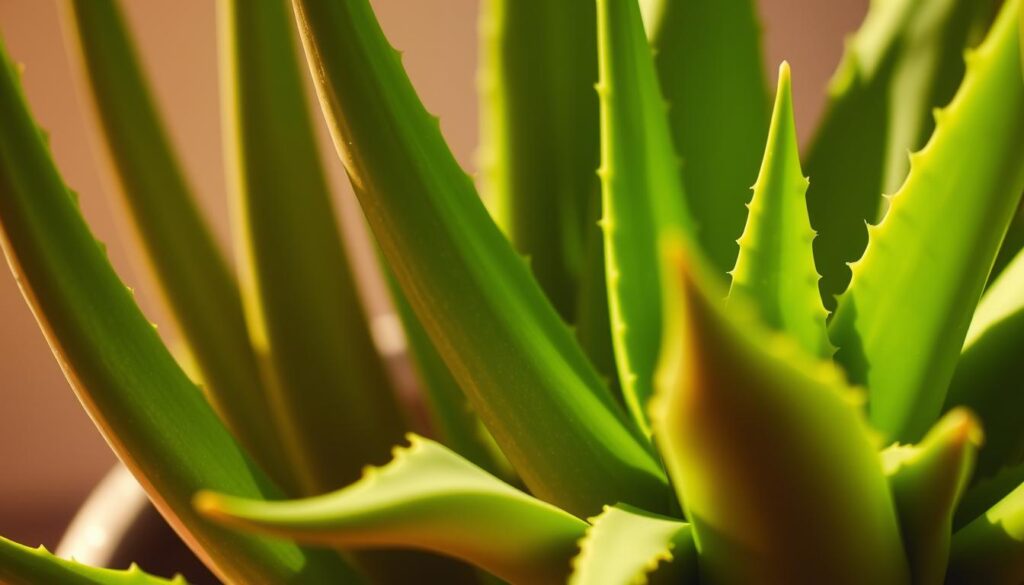
How to Extract and Use Fresh Aloe Vera Gel
To harness the full potential of aloe vera for sunburn relief, it’s essential to know how to extract and use its gel properly. Fresh aloe vera gel is a potent natural remedy that can be used to soothe sunburned skin, reduce inflammation, and promote healing.
Selecting and Harvesting Aloe Leaves
The first step in extracting aloe vera gel is selecting the right leaves. Choose mature leaves from the outer part of the aloe vera plant, as they contain more gel. When harvesting, cut the leaf close to the base of the plant using a sharp knife. It’s crucial to handle the leaves carefully to avoid damaging them and to minimize the latex exposure.
Step-by-Step Extraction Process
Extracting aloe vera gel involves a few simple steps:
- Rinse the harvested leaf under cool running water to remove any dirt.
- Pat the leaf dry with a clean towel.
- Cut off the thorny edges and slice the leaf open lengthwise.
- Scoop out the clear gel using a spoon, avoiding the yellow latex layer beneath the skin.
- Rinse the gel under cold water to remove any remaining latex.
This process ensures that you obtain pure aloe vera gel, free from latex that can cause skin irritation.
Storage Tips for Maximum Potency
To maintain the potency of the extracted aloe vera gel, it’s essential to store it properly. You can store it in an airtight container in the refrigerator for up to a week. For longer storage, consider freezing the gel in ice cube trays. This way, you can have a steady supply of fresh aloe vera gel for sunburn relief and other skin care needs.
Using fresh aloe vera gel is a simple and effective way to leverage its natural healing properties for sunburn relief. By following these steps, you can enjoy the benefits of aloe vera in the comfort of your home.
Choosing the Best Aloe Vera Products for Sunburn
The quest for the perfect aloe vera product for sunburn relief requires careful consideration of several key factors. With so many options available, it’s essential to know what to look for to ensure you’re getting a product that is both effective and safe for your skin.
What to Look for on Product Labels
When shopping for aloe vera products, the label can be a treasure trove of information. Look for products with high concentrations of aloe vera, as these are likely to be more effective. A concentration of 90% or higher is generally considered good. Additionally, check for other beneficial ingredients that can enhance the product’s soothing and moisturizing properties.
Some beneficial ingredients to look out for include:
- Vitamin E, which can help in skin healing and protection.
- Antioxidants, which combat free radicals and promote healthier skin.
- Natural moisturizers like coconut oil or shea butter, which can help lock in moisture.
Ingredients to Avoid in Commercial Aloe Products
Not all ingredients in commercial aloe vera products are beneficial. Some can even irritate the skin or reduce the product’s effectiveness. Avoid products containing alcohol, as it can dry out the skin and cause irritation. Similarly, fragrances and artificial colors can be irritating and should be avoided, especially on sunburned skin.
| Ingredient | Reason to Avoid |
|---|---|
| Alcohol | Dries out the skin, causes irritation |
| Fragrances | Can irritate sunburned skin |
| Artificial Colors | Potential skin irritants |
Top-Rated Aloe Vera Gels and Sprays
Several aloe vera products stand out for their quality and effectiveness. Here are a few top-rated options:
- Aloe vera gel from brands like Lily of the Desert and Nature Republic, known for their high aloe concentration and soothing properties.
- Aloe vera sprays from companies like Aloecorp and Fruit of the Earth, which offer convenient application and quick relief.
When choosing between gels and sprays, consider your skin type and personal preference. Gels are often more moisturizing, while sprays can be more convenient for applying to larger areas or for use on-the-go.
Step-by-Step Guide to Applying Aloe Vera for Sunburn Relief
To maximize the benefits of aloe vera for sunburn relief, it’s essential to apply it correctly. Aloe vera gel is renowned for its soothing properties, but its effectiveness can be enhanced by following a simple, step-by-step application process.
Preparing Your Skin for Application
Before applying aloe vera gel, ensure your skin is prepared properly. Cool the skin by taking a cool bath or shower, or by applying a cool compress. This step helps reduce the skin temperature, making it more receptive to the aloe vera gel.
Pat dry the affected area gently with a towel. Avoid rubbing, as this can further irritate the sunburned skin.
Proper Application Techniques
Using aloe vera gel correctly is crucial for optimal sunburn relief. Apply a generous amount of aloe vera gel to the affected area. Gently massage it into the skin until it’s fully absorbed.
As noted by Dr. Joshua Zeichner, a dermatologist, “Aloe vera gel can help soothe sunburned skin by reducing inflammation and promoting hydration.”
“Aloe vera has anti-inflammatory properties that can help alleviate the discomfort associated with sunburn.”
Frequency and Duration of Treatment
For maximum relief, aloe vera gel should be reapplied every 2-4 hours. Continue this regimen until the sunburn has healed, typically within 3 to 5 days.
Consistency is key when using aloe vera for sunburn relief. Regular application not only soothes the skin but also aids in the healing process.
DIY Aloe Vera Remedies for Enhanced Sunburn Relief
Aloe vera becomes even more effective when paired with other natural ingredients in DIY sunburn remedies. By combining aloe vera with complementary elements, you can create treatments that not only soothe but also nourish your skin, promoting faster healing and relief from sunburn discomfort.
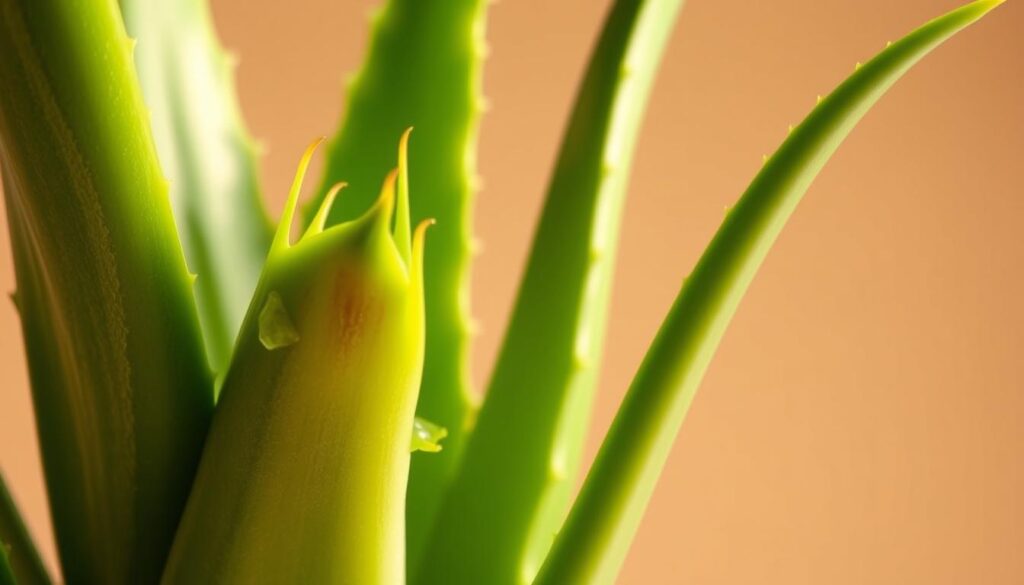
Cooling Aloe and Cucumber Blend
One of the most refreshing ways to utilize aloe vera for sunburn relief is by blending it with cucumber. Cucumber’s cooling properties complement aloe vera’s soothing effects, creating a potent remedy for reducing heat and inflammation. To make this blend, simply puree a cucumber and mix it with fresh aloe vera gel. Apply this cooling mask to the affected areas and leave it on for 15-20 minutes before rinsing off with cool water.
Moisturizing Aloe and Coconut Oil Treatment
For sunburned skin that feels dry and tight, a moisturizing treatment combining aloe vera and coconut oil can be incredibly beneficial. Coconut oil’s rich fatty acids help lock in moisture, while aloe vera’s anti-inflammatory properties soothe the skin. Mix equal parts of aloe vera gel and coconut oil, and gently apply it to the sunburned areas. This treatment not only moisturizes but also aids in the healing process, reducing the risk of peeling and promoting healthier skin recovery.
Soothing Aloe and Essential Oil Combinations
Certain essential oils, when combined with aloe vera, can enhance its soothing effects on sunburned skin. Lavender oil, known for its calming properties, can be mixed with aloe vera to create a soothing sunburn spray. Tea tree oil, with its antiseptic properties, can help prevent infection in blistered areas. When using essential oils, it’s crucial to dilute them properly in aloe vera gel to avoid skin irritation. A general guideline is to use a few drops of essential oil per tablespoon of aloe vera gel. Always perform a patch test before applying any new skincare treatment extensively.
These DIY remedies not only provide relief from sunburn but also offer a natural, cost-effective way to care for your skin. By harnessing the power of aloe vera and other natural ingredients, you can create personalized treatments tailored to your skin’s specific needs.
When to Seek Medical Help: Beyond Aloe Vera for Sunburn
Aloe vera can soothe sunburned skin, but it’s essential to recognize the signs that indicate a need for professional medical care. While aloe vera is effective for mild sunburn relief, severe cases may require more than just home treatment.
Warning Signs of Severe Sunburn
Severe sunburn can manifest in various ways, including blistering, fever, and dehydration. If you experience any of these symptoms, it’s crucial to seek medical help. Additionally, if your sunburn covers a large area of your body or is accompanied by severe pain, medical attention is recommended.
Some specific warning signs to watch out for include:
- Blistering or peeling skin
- Fever or chills
- Dehydration symptoms like dizziness or dry mouth
- Severe pain that doesn’t improve with over-the-counter pain relievers
Medical Treatments for Serious Burns
For severe sunburns, medical treatments may include prescription medications, wound care, and hydration therapy. In some cases, hospitalization may be necessary to manage dehydration and prevent infection. A healthcare professional can assess the severity of your sunburn and recommend the appropriate treatment.
It’s also important to note that certain individuals, such as those with fair skin or a history of skin cancer, may need to be more vigilant about seeking medical help for sunburn. Prevention is key, and understanding when to seek help can make a significant difference in recovery and long-term skin health.
Conclusion: Incorporating Aloe Vera into Your Sun Care Routine
Incorporating aloe vera into your sun care routine can be a game-changer for soothing and healing sunburned skin. With its rich composition of polysaccharides, anti-inflammatory agents, and antioxidants, aloe vera provides aloe vera benefits for skin that are hard to ignore. Whether you opt for fresh aloe vera gel or a commercial product, using aloe vera for sunburn relief can significantly reduce discomfort and promote faster recovery.
By understanding the aloe vera for sunburn relief and exploring various natural sunburn remedies with aloe vera, you can make informed choices about your sun care. Remember, prevention is key, but when sunburn does occur, aloe vera is a reliable and effective solution. Make aloe vera a staple in your sun care arsenal to enjoy healthier, happier skin all year round.
FAQ
What are the benefits of using aloe vera for sunburn relief?
Aloe vera provides several benefits for sunburn relief, including hydration, skin barrier repair, reduction of redness and swelling, and pain relief due to its polysaccharides, anti-inflammatory agents, antioxidants, and natural analgesics.
How does aloe vera help with sunburn blisters?
Aloe vera can help soothe sunburn blisters by keeping the skin hydrated and reducing inflammation, which can aid in the healing process and reduce the risk of infection.
Can I use aloe vera gel directly from the plant for sunburn relief?
Yes, you can use aloe vera gel directly from the plant for sunburn relief. However, ensure you extract the gel correctly, avoiding the yellow latex to prevent skin irritation.
What should I look for when buying aloe vera products for sunburn?
When purchasing aloe vera products, look for high aloe vera concentration, and avoid products containing alcohol and fragrances, which can irritate sunburned skin.
How often should I apply aloe vera for sunburn relief?
For optimal relief, apply aloe vera gel every 2–4 hours. Reapplication can help maintain its soothing and moisturizing effects on sunburned skin.
Can aloe vera be used in combination with other natural ingredients for sunburn relief?
Yes, aloe vera can be combined with other natural ingredients like cucumber, coconut oil, and essential oils to create cooling, moisturizing, and soothing treatments for enhanced sunburn relief.
Is aloe vera effective for all types of sunburn?
Aloe vera is effective for mild to moderate sunburn. However, for severe sunburn or burns that blister, are extremely painful, or show signs of infection, medical attention may be necessary beyond self-care with aloe vera.
How does aloe vera sunburn spray compare to aloe vera gel?
Aloe vera sunburn spray can be more convenient for applying to larger areas or harder-to-reach parts of the body, while aloe vera gel may provide a thicker, more moisturizing layer. Both can be effective for sunburn relief.
Can aloe vera help reduce the redness associated with sunburn?
Yes, aloe vera contains anti-inflammatory agents that can help reduce redness and swelling associated with sunburn, promoting a more comfortable recovery.
